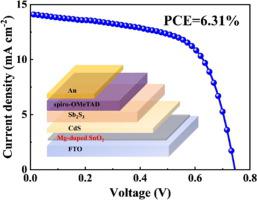Journal of Energy Chemistry ( IF 13.1 ) Pub Date : 2021-08-19 , DOI: 10.1016/j.jechem.2021.08.029 Jiashuai Li 1, 2 , Liangbin Xiong 3 , Xuzhi Hu 1, 2 , Jiwei Liang 1, 2 , Cong Chen 1, 2 , Feihong Ye 1, 2 , Jing Li 1, 2 , Yongjie Liu 1, 2 , Wenlong Shao 1, 2 , Ti Wang 1 , Chen Tao 1, 2 , Guojia Fang 1, 2

|
Antimony sulfide (Sb2S3) is an appealing semiconductor as light absorber for solar cells due to its high absorption coefficient, appropriate band gap (~1.7 eV) and abundance of constituent elements. However, power conversion efficiency (PCE) of Sb2S3-based solar cells still lags much behind the theoretically predicted due to the imperfect energy level alignment at the charge transporting layer/Sb2S3 interfaces and hence severe charge recombination. Herein, we insert a high-temperature sintered magnesium (Mg)-doped tin oxide (SnO2) layer between cadmium sulfide (CdS) and fluorine doped tin oxide to form a cascaded energy level alignment and thus mitigate interfacial charge recombination. Simultaneously, the inserted Mg-doped SnO2 buffer layer facilitates the growth of the neibouring CdS film with orientation followed by Sb2S3 film with larger grains and fewer pinholes. Consequently, the resultant Sb2S3 solar cells with Mg-doped SnO2 deliver a champion PCE of 6.31%, 22.8% higher than those without a buffer layer. Our work demonstrates that deliberate absorber growth as well as efficient hole blocking upon an appropriate buffer layer is viable in obtaining solution-processed Sb2S3 solar cells with high performance.
中文翻译:

使用掺杂镁的氧化锡缓冲层操纵 CdS/Sb2S3 异质结的形态,用于高效太阳能电池
硫化锑 (Sb 2 S 3 ) 因其高吸收系数、合适的带隙 (~1.7 eV) 和丰富的组成元素而成为一种有吸引力的半导体,作为太阳能电池的光吸收剂。然而,由于电荷传输层/Sb 2 S 3界面处的能级排列不完善,因此基于Sb 2 S 3的太阳能电池的功率转换效率(PCE)仍然远远落后于理论预测值,从而导致严重的电荷复合。在这里,我们插入了高温烧结的镁(Mg)掺杂氧化锡(SnO 2) 硫化镉 (CdS) 和掺氟氧化锡之间的层以形成级联能级排列,从而减轻界面电荷复合。同时,插入的 Mg 掺杂 SnO 2缓冲层促进了具有取向的 neibouring CdS 膜的生长,然后是具有更大晶粒和更少针孔的Sb 2 S 3膜。因此,所得的具有掺杂 Mg 的 SnO 2 的Sb 2 S 3太阳能电池提供了 6.31% 的最佳 PCE,比没有缓冲层的电池高 22.8%。我们的工作表明,在适当的缓冲层上有意的吸收剂生长以及有效的空穴阻挡对于获得溶液处理的 Sb 2 S是可行的3个高性能太阳能电池。


























 京公网安备 11010802027423号
京公网安备 11010802027423号